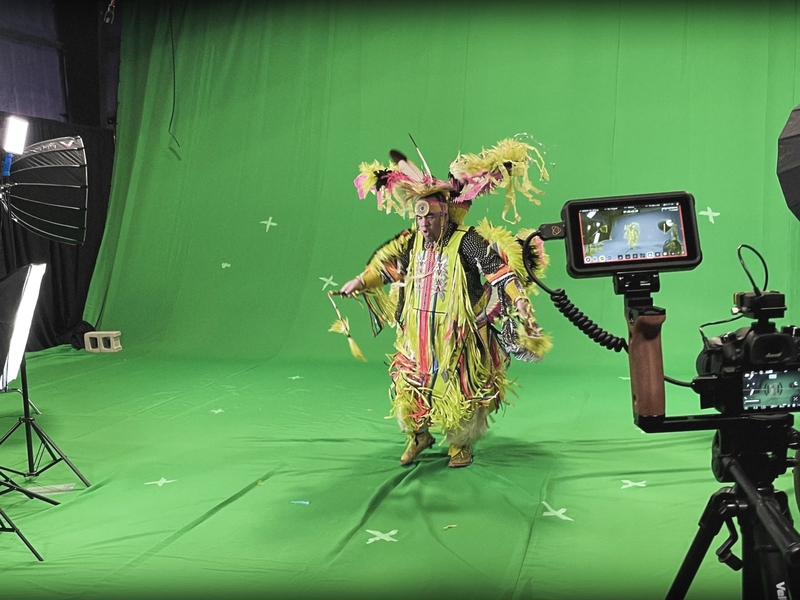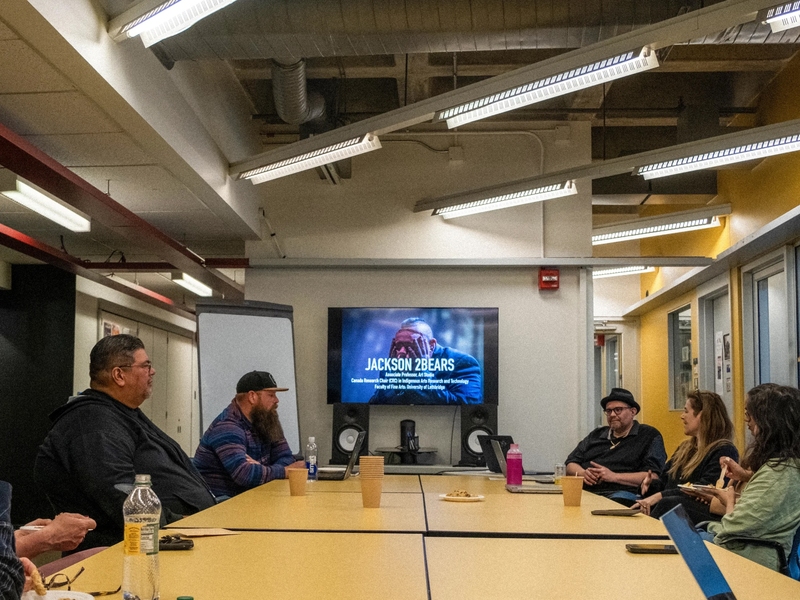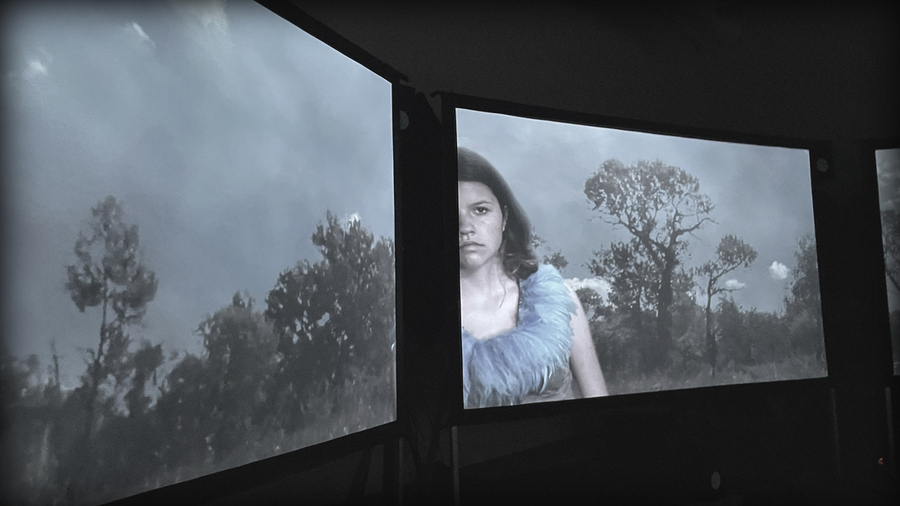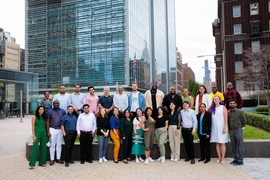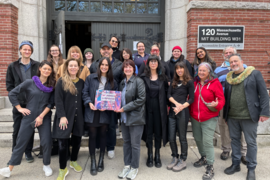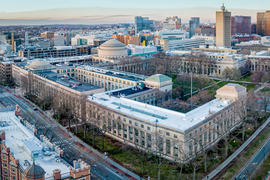In the beginning, as one version of the Haudenosaunee creation story has it, there was only water and sky. According to oral tradition, when the Sky Woman became pregnant, she dropped through a hole in the clouds. While many animals guided her descent as she fell, she eventually found a place on the turtle’s back. They worked together, with the aid of other water creatures, to lift the land from the depths of these primordial waters to create what we now know as our earth.
The new immersive experience, “Ne:Kahwistará:ken Kanónhsa’kówa í:se Onkwehonwe,” is a vivid retelling of this creation story by multimedia artist Jackson 2bears, also known as Tékeniyáhsen Ohkwá:ri (Kanien’kehà:ka), the 2022–24 Ida Ely Rubin Artist in Residence at the MIT Center for Art, Science and Technology. “A lot of what drives my work is finding new ways to keep Haudenosaunee teachings and stories alive in our communities, finding new ways to tell them, but also helping with the transmission and transformation of those stories as they are for us, a living part of our cultural practice,” he says.
A virtual recreation of the traditional longhouse
2bears was first inspired to create a virtual reality version of a longhouse, a traditional Haudenosaunee structure, in collaboration with Thru the RedDoor, an Indigenous-owned media company in Six Nations of the Grand River that 2bears calls home. The longhouse is not only a “functional dwelling,” says 2bears, but an important spiritual and cultural center where creation myths are shared. “While we were developing the project, we were told by one of our knowledge keepers in the community that longhouses aren’t structures, they’re not the materials they’re made out of,” 2bears recalls, “They’re about the people, the Haudenosaunee people. And it’s about our creative cultural practices in that space that make it a sacred place.”
The virtual recreation of the longhouse connects storytelling to the physical landscape, while also offering a shared space for community members to gather. In Haudenosaunee worldview, says 2bears, “stories are both durational, but they’re also dimensional.” With “Ne:Kahwistará:ken Kanónhsa’kówa í:se Onkwehonwe,” the longhouse was brought to life with drumming, dancing, knowledge-sharing, and storytelling. The immersive experience was designed to be communal. “We wanted to develop a story that we could work on with a bunch of other people rather than just having a story writer or director,” 2bears says, “We didn’t want to do headsets. We wanted to do something where we could be together, which is part of the longhouse mentality,” he says.
The power of collaboration
2bears produced the project with the support of Co-Creation Studio at MIT’s Open Documentary Lab. “We think of co-creation as a dance, as a way of working that challenges the notion of the singular author, the single one point of view,” says documentarian Kat Cizek, the artistic director and co-founder of the studio, who began her work at MIT as a CAST visiting artist. “And Jackson does that. He does that within the community at Six Nations, but also with other communities and other Indigenous artists.”
In an individualist society that so often centers the idea of the singular author, 2bears’s practice offers a powerful example of what it means to work as a collective, says Cizek. “It’s very hard to operate, I think, in any discipline without some level of collaboration,” she says, “What’s different about co-creation for us is that people enter the room with no set agenda. You come into the room and you come with questions and curiosity about what you might make together.”
2bears at MIT
At first, 2bears thought his time at MIT would help with the technical side of his work. But over time, he discovered a rich community at MIT, a place to explore the larger philosophical questions relating to technology, Indigenous knowledge, and artificial intelligence. “We think very often about not only human intelligence, but animal intelligence and the spirit of the sky and the trees and the grass and the living earth,” says 2bears, “and I’m seeing that kind of reflected here at the school.”
In 2023, 2bears participated in the Co-Creation Studio Indigenous Immersive Incubator at MIT, an historic gathering of 10 Indigenous artists, who toured MIT labs and met with Indigenous leaders from MIT and beyond. As part of the summit, he shared “Ne:Kahwistará:ken Kanónhsa’kówa í:se Onkwehonwe” as a work in progress. This spring, he presented the latest iteration of the work at MIT in smaller settings with groups of students, and in a large public lecture presented by CAST and the Art, Culture and Technology Program. His “experimental method of storytelling and communication really conveys the power of what it means to be a community as an Indigenous person, and the unique beauty of all of our people,” says Nicole McGaa, Oglala Lakota, co-president of MIT’s Native American Indigenous Association.
Storytelling in 360 degrees
2bear’s virtual recreation became even more important after the longhouse in the community unexpectedly burned down midway through the process, after the team had created 3D scans of the structure. With no building to project onto, they used ingenuity and creativity to pivot to the project’s current iteration.
The immersive experience was remarkable in its sheer size: 8-foot tall images played on a canvas screen 34 feet in diameter. With video mapping using multiple projectors and 14-channel surround sound, the story of Sky Woman coming down to Turtle Island was given an immense form. It premiered at the 2RO MEDIA Festival, and was met with an enthusiastic response from the Six Nations community. “It was so beautiful. You can look in any direction, and there was something happening,” says Gary Joseph, director of Thru the RedDoor. “It affects you in a way that you didn’t think you could be affected because you're seeing the things that are sacred to you being expressed in a way that you’ve never imagined.”
In the future, 2bears hopes to make the installation more interactive, so participants can engage with the experience in their own ways, creating multiple versions of the creation story. “I’ve been thinking about it as creating a living installation,” he says. “It really was a project made in community, and I couldn’t have been happier about how it turned out. And I’m really excited about where I see this project going in the future.”
